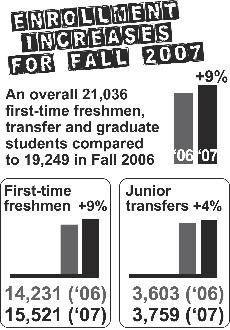Growth outlook unclear

Growth outlook unclear
February 27, 2007
A 9 percent spike in enrollment applications for fall 2007 offers hope but no promises to ending Sacramento State’s enrollment slump.
“These are early signs we’re seeing. So far we feel good about it, but it’s still too early to read anything into it,” Director of Outreach, Admissions and Records Emiliano Diaz said.
Diaz said figures derived on January 1 show that 21,036 freshmen, transfer and graduate students have applied for fall 2007, a 9 percent increase from fall 2006’s 19,249 applications. Freshmen applicants jumped from 14,231 for fall 2006 to 15,521. Prospective junior transfer students increased from 3,603 to 3,759.
Larry Glasmire, director of Special Programs and Enrollment Analysis, said he was pleased with the news because the university hasn’t met its target growth in three years.
“My expectation for next year is that we’ll actually exceed our target a little bit,” Glasmire said.
Even with the increase, Diaz said he believes the university can still accommodate more students.
“It’s unlikely that we’ll turn anyone down who is eligible and who applied by the priority filing date (November 2006),” the admissions director said. “We’re remaining open (to accepting applications).”
A broadened applicant pool usually spells hope for any college or university since enrollment and funding are essentially related.
The California State Legislature, through a board of governing trustees, funds each college or university based on a projected target of full-time equivalent students enrolled during the academic year. The number of full-time equivalent students is derived by considering how many units taken by the entire student population divide into individual full-time student loads which is around12 or 15 units.
While meeting or exceeding the target secures funds allocated, falling short of the target would mean that a college or university would have to pay back a portion of the funds.
Provost Joseph Sheley believes the rise in fall applications offers a lot of hope for the University.
“It makes us feel more likely to hit our (full-time equivalent student) target,” Sheley said. The provost said that declining enrollment trends and budget issues have prompted conservative enrollment goals for Sac State.
“Because of both enrollment trends and budget issues, we made the decision to stick with our current enrollment level,” Sheley said. “We’re trying to increase our control over enrollment and therefore our budget.
“The 9 percent increase in applications is a good sign that we should hit that target,” he said.
Diaz said seeking enrollment stability would also benefit students.
“We’re trying to give ourselves an opportunity to stabilize. We just want to make sure we can provide for who’s here,” Diaz said.
But Sheley is skeptical that the sudden surge in applications really equates to more prospective students.
“‘You’ve got a 9 percent increase in applications’ does not translate to an increase in enrollment,” Sheley said. “What makes it difficult to predict (enrollment) is that the medium by which to apply has changed everything.”
Sheley believes the ease afforded by standardized applications submitted via the Internet have allowed students to send out more applications and flood admissions offices in several universities and colleges.
“At that point, it’s just a matter of how many applications can you afford to send out,” Sheley said. “The application process has gotten so much easier prospective students are more likely to apply to multiple campuses at once.”
In the end however, it’s one student whose admissions decision, Sheley said, universities and colleges must compete for.
“The issue is: now that they’ve applied, are we going to be the place they choose to attend?” the provost said.
Regardless of how accurate the upsurge of fall enrollment applications is to predicting enrollment, Sheley is glad that Sac State is among the educational institutions to see an increase since the current enrollment climate has those institutions competing for students.
“The high school generation is flattening out and we all have to go out there and get them to come here,” Sheley said. Glasmire said the future looks bright. “we can expect growth for the next two years,” he said.
Marilen Bugarin can be reached at [email protected]
























































































































